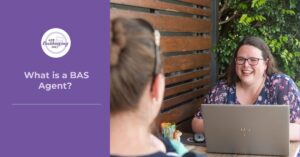Online banking is becoming more and more popular across the world. It’s a convenient way to manage both business and personal finances. Like anything, however, it comes with risks, particularly those associated with anything online (including having your accounts and personal information stolen).
The Australian Government eSafety Commissioner website has some excellent tips on how to stay safe when using online banking. The Australian Cyber Security Centre website has some excellent tips and guides as well.
In this blog post, I’ll share some of the top tips (which are also easy to implement!) for staying safe when doing online banking.
Turn on multi-factor authentication (MFA)
Turning on multi-factor authentication (also known as MFA or 2FA – short for ‘2 Factor Authentication’) makes it harder for unauthorised persons to access your accounts. MFA (or 2FA) means you need two or more pieces of information to be able to login. For example, logging into an account with your username and password (first piece of information), and then using a unique code from a text message (second piece of information).
Using MFA where possible (while it can be cumbersome) is an important step in protecting your personal and business information and accounts, especially when doing online banking.
Use strong passwords or passphrases
In this online world where everything requires a new password, we all realise that the first defense (best practice) is to have a unique password for each different login. However, the reality is, our brains can become overwhelmed with information, and we then default to using the same (or a variation of) password for many different logins.
This is where using a password manager to create and store unique and strong passwords or passphrases for each of your accounts, is vital. There are many great password managers available(LastPass, Google Password Manager, NordPass, DashLane and RoboForm just to name a few), and many of them have free accounts for single users.
For accounts you sign into often (such as your password manager!), consider using a passphrase. A passphrase is a more secure version of a password, made up of four or more random words, and at least 14 characters long.
Update your software
Keeping software up to date is one of the best and easiest way to protect your personal and business details from a cyber attack.
Software updates are released regularly in a lot of cases, and often include fixes or patches for known weaknesses. Regular updates will reduce the chance of a cybercriminal using a known weakness to access and control your device/s.
Turn on automatic updates where possible, and make a habit of checking for updates on all devices on a regular basis (for example: once a month on the same date).
If you have a device that is too old to receive updates, consider upgrading your device to a newer product.
Keep devices locked and physically secure
Restricting physical access to your device/s will reduce opportunities for unauthorised activity.
To prevent unauthorised use, keep your device/s secure with a password, PIN or biometric lock (face ID or fingerprint), set them to lock after a short time of no use, and keep them locked away in a secure location when not in use for longer periods of time.
By taking these simple steps, you can help prevent unauthorised access to your business bank accounts (and other sensitive business details).
For more information & resources, I recommend taking a look at the following websites:
Australian eSafety Commissioner website




